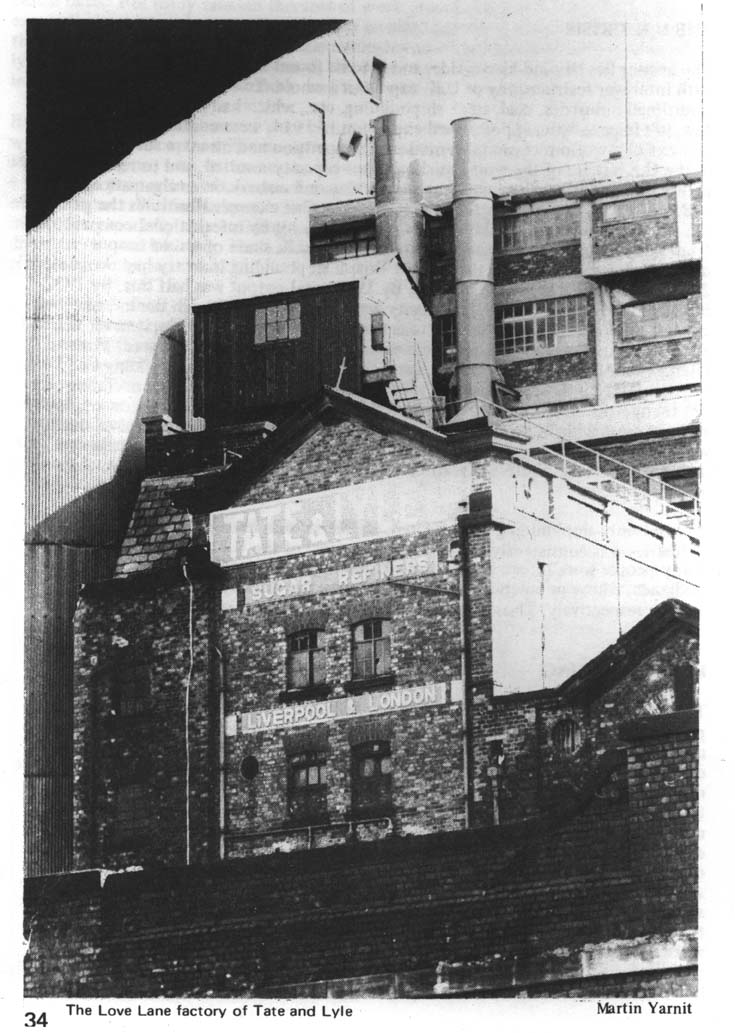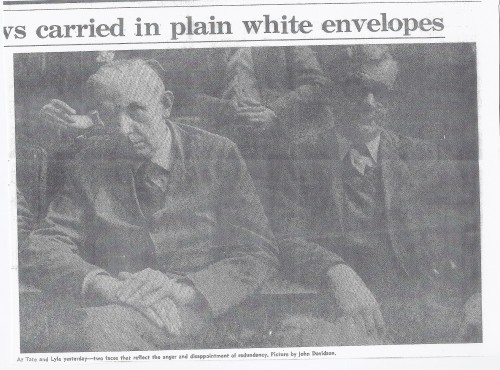Love Lane Lives
The history of sugar in Liverpool and the effects of the closure of the Tate & Lyle sugar refinery, Love Lane
Bitter Sweet Memories: “MEMORY IS LIFE!”
Written by Ron Noon at 15:08 on Monday, November 21st 2011
MEA CULPA, MEA CULPA, MEA MAXIMA CULPA! That’s a rather posh latin apology for the near seven months of my failure to blog! I do have PMCs, (personal mitigating circumstances is the term we used at LJMU to describe student “excuses” for late submissions of assignments), and I will get round eventually to explaining why my sugar sabbatical has not been entirely unproductive.
FIRST THOUGH THE SUGAR “BUSINESS AS USUAL”.
Larry McShane a journalist at Associated Press when writing about the closure of the Domino Sugar Refinery in Brooklyn New York in January 2004 noted that the iconic building with its familiar red neon sign overlooking the East River and the most expensive real estate in the Cosmos had predated the Brooklyn Bridge and “outlasted the Brooklyn Dodgers”! After 148 years of refining in the Big Apple “Domino” like “Love Lane” in Liverpool, (described ten years after Henry Tate set up his state of the art mother refinery as “the New York of Europe, a world city”), closed down, leaving its workers with nothing more than memories. Domino had been owned by Tate & Lyle before it was sold to the American Refining Company in 2001, suggesting that the links in this sugar chain between the Lane and the Williamsburg Bridge crossing the East River, are not just random and coincidental. This was another version of history repeating itself as tragedy in the same way as closure had blighted the lives and community of the boys and girls from the Liverpool whitestuff 23 years earlier.
The M word was used by Ted Sampson from North Wales on our Comments page last week when he wrote about about his late mother Betty Sampson who had worked in Tates as a cleaner before retiring in 1968/1969. “Wow…Brilliant film…that brought back memories.” Thanks for that compliment Ted and yes our site is about helping to preserve memories and ensure that Love Lane lives do indeed live on. With the kind of contributions from you and other former Tates employees like the “2 Mikes” (Mike Wray aka MWW from the Wirral, and Mike Greenhall from New Zealand) we can hopefully help create a “virtual community” of former workers and their lived experiences. There are so many who have already written in and I would encourage some readers to overcome inhibitions and record or report their own or family members experiences of Love Lane Lives. (Not everyone is familiar with computers and webpages including my great mate Albert but all stories and comments can be printed off.)
The M word was also prominent in a sad, unsigned letter, doing the rounds of the historic Domino Sugar Refinery in Brooklyn, New York a week before it closed down. The advice it gave to 280 workers suffering from a growing sense of terminal nostalgia for a way of working life about to end, was “make sure you don’t leave your memories behind, because they are our entire world”. Surplus sugar cane capacity in an increasingly anachronistic plant was the ostensible reason for the matricide of what had famously been the original refinery of 19th century American Sugar Baron, Henry Haveymeyer, whose American Sugar Refining Company, a century earlier was one of the ten biggest and most profitable companies in the world. (What had been written before its closure about “the increasingly anachronistic Love Lane plant”?)
Perhaps the real reason for the end of Sugar Cane time in the Big Apple may have had more to do with the real estate potential of the 11 and a half acre site, and its vantage point looking out across the East River to lower Manhattan. (Due respect to MWW on the Wirral but New Brighton is not New York!) That glittering world of condos and loft apartments, housing Wall St. brokers and artists, although geographically close to Brooklyn’s blue collar workers was socially a million miles away at the end of the shift on Friday 30th January 2004. The boys and girls from New York’s White Stuff were now former costs of production whose memories the letter poignantly concluded “are the only things we keep”.

“Memory is life.” The 30th anniversary of the closure of Love Lane, Henry Tate’s mother refinery was the last occasion when I blogged! April 22nd is a poignant date irrevocably seared into the collective memories of the boys and girls from the whitestuff whose agonizing job insecurity intensified on January 22nd 1981 with the issuing of 90 day redundancy notices. This website symbolizes the extent to which Love Lane lives do indeed live on but the overwhelming sense of terminal loss when the refinery closed down is very difficult to do justice to. The Marxist historian Eric Hobsbawm in Age of Empire made specific reference to the difficulties of writing a dispassionate history of a period through which one has lived. Hobsbawm quotes French writer Pierre Nora who affirms that “history is the always incomplete and problematic reconstruction of what is no longer there” and how “memory always belongs to our time and forms a lived bond with the eternal present”.
I tried to convey some of the pathos of closure by making accessible online a number of the newspaper accounts of that tragic period and of Tate & Lyle’s leaving and grieving of Liverpool. “Where do I go from here? The dole I suppose.” That comment was typical of so many to the closure announcement and as an historian, albeit a sympathetic historian I had not lived that pain and demoralisation. The newspapers only tell part of the story. The rest has to be written up by former refinery workers.
Trying to write up stuff while on half term holiday with our grandchildren back in February was a sneaky way of trying to keep the blogs fresh and pertinent during the “90 days”. Writing blogs in Kayall Road public library in Sunderland was another stimulus because it gave me access to the web while my wife was visiting her elderly mother. Somebody once said that history is not so much what happened as what contemporaries perceived to be happening at the time. For me “at the time in question” there seemed so much more to be done when I safely returned to my computer back home in Allerton.
How and why did I “dry up” in mid April? Even the much welcomed anniversary coverage in the Liverpool Daily Post and Liverpool Echo failed to re-charge my sugar-fuelled batteries. It was not as though there was zilch in the sugar world to write about but something I’d embarked on at the very end of 2010, was deflecting my bitter sweet thoughts elsewhere.
I was and continue to be a Labour and trade union historian which was how and why I first got involved with my two sweet fightin’ mentors Albert E Sloane and John Maclane, but also why 2011 and a centennial anniversary of a seminal event in the history of the Liverpool working class became more compelling. I was committed to do something about the Liverpool General Transport Strike of 1911 with a non-sugar centric friend and former colleague and it “crowded out” everything else. Sam Davies and I have now successfully deployed our historical knowledge and passion to commemorate the memory of John Sutcliffe, a carter and Michael Prendergast, a docker, shot dead by the military on August 15th 1911.
The 20 year old Sutcliffe and 29 year old Prendergast were not “rioters”. They were innocent victims of what Sam is now investigating as a shoot to kill directive. Where they were shot (Sutcliffe was “murdered” on the corner of Hopwood Street and Vauxhall Road) was right inside the sugar land area just north of the city centre that this website of ours is focussed on. With the help and backing of the North West TUC and THE CASA in Hope Street we have succeeded in ensuring that there will be a commemoration plaque to remind people of the horrendous consequences of deploying armed troops when dealing with striking workers seeking union recognition.
The surviving relatives of John Sutcliffe who was due to be married three weeks later were traced by Sam’s forensic researches and on November 7th on the BBC North West Inside Out programme there was a feature involving Sam and I and Sutcliffe’s relatives.
That said I did a good deal of writing and research with Sam on 1911 but the real forensics of working through documents at Kew Record Office and tracing the family histories was down to Sam. Tony McGann of the Eldonians once again turned up trumps and allowed us to use the Eldonian Village Hall for a 15th of August Centennial Commemoration event sponsored by the North West TUC. How shocking and sickening was the news relayed on our comments column by Mike Wray of the arson attack on the Village Hall and the devastation it has left in its wake? The indomitable spirit of Tony McGann and the Eldonians will ensure another rise of the Phoenix but they will surely need help and assistance and I’m convinced there are many familiar with this website more than willing to support a campaign to restore the Hall to its former community glory. It was of course built on the FAIRRIES part of the Love Lane refinery.
The Russian poet Joseph Brodsky wrote in 1986 that “if there is any substitute for love, it is memory”. That’s why the surviving relatives of Sutcliffe and Prendergast will know that although they can’t bring them back, they can now at least remember their legacy in an environment which thanks to this type of public history project will ensure a collective respect and memory of the young lives lost in the cause of social justice and a better tomorrow. Sam and I felt very proud of what we’d been able to uncover and Sam will now write up much more than what was included in our joint pamphlet published back in August. I can now get back to my achingly addictive Sucrose studies.
P.S. What about this Paul Theroux comment in MY SECRET HISTORY?
“One of the greatest things that writers did, I thought, was to isolate an event, and light it with imagination, to make people understand and remember; and not just events, but people and their passions. Forgetting was much worse than failure; it was an act of violence…For all writing aimed at defeating time. No one could become a writer - no one could even care about it - until he or she experienced the impartial cruelty of time passing.”

The writing is too small to make out on this scan but this is what the reader would have read on January 23rd 1971:
“At Tate & Lyle yesterday - two faces that reflect the anger and disappointment of redundancy.” The picture was by John Davidson.
It certainly takes more than Liverpool’s Paul McArtney to evoke the pain of YESTERDAY, a yesterday experience that will tragically become tomorrow’s experience for millions more in 2012 unless….